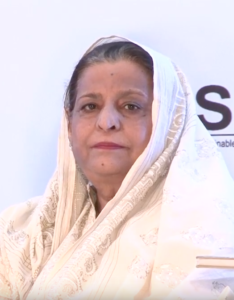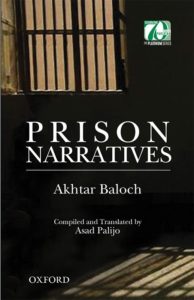Past Forward
By Afsheen Ahmed | Books | Published 8 years ago

Akhtar Baloch
 At 18, the youngest female political prisoner in Pakistan, Akhtar Baloch was sentenced to a one-year prison term by a military court in 1970 for leading the students protest against the military regime of Yahya Khan in 1970. Baloch kept a diary of her alternating time spent in Central Jail Hyderabad and Central Jail Sukkur. It was published in 1972 in Sindhi as Qaidyani Ji Diary. It has now been translated into English by her son, Asad Palijo. The Sindhi students protest which led to hunger strikes in 1969-70, was for the abolition of the One Unit and for electoral rolls and voter forms for the general elections announced for 1970, to be published in Sindhi.
At 18, the youngest female political prisoner in Pakistan, Akhtar Baloch was sentenced to a one-year prison term by a military court in 1970 for leading the students protest against the military regime of Yahya Khan in 1970. Baloch kept a diary of her alternating time spent in Central Jail Hyderabad and Central Jail Sukkur. It was published in 1972 in Sindhi as Qaidyani Ji Diary. It has now been translated into English by her son, Asad Palijo. The Sindhi students protest which led to hunger strikes in 1969-70, was for the abolition of the One Unit and for electoral rolls and voter forms for the general elections announced for 1970, to be published in Sindhi.
Akhtar Baloch, the strong-minded, idealistic daughter of left-leaning, staunch political activists — the famed folk singer of Sufi songs, ‘Jiji’ Zarina Baloch and her writer/lawyer stepfather, Rasool Bux Palijo — was deeply affected by the brutal crackdown and arrest by the police of male student hunger strikers in Hyderabad in October 1969 and decided to take action. Both her parents were hospitalised in Jamshoro at the time, and Akhtar was looking after them. She asked them for permission to go on a hunger strike, the first for a young girl in that milieu, to carry on the protest when the male students had been forcibly removed. “Why not?” was the immediate response. Though they warned her of the consequences — jail, discomfort — they made no attempt to stop her. As she was leaving, her mother advised her, “Take some bedding with you.” True comrades.
Akhtar began her first stint at a hunger strike the next afternoon — November 19, 1969 — sitting on the pavement outside the Deputy Commissioner’s residence in Hyderabad, with hastily made placards. A stream of people came by to try and dissuade her from going on a hunger strike, including her college principal, but Akhtar was adamant. Others said this was “a job best left to male students who could face the consequences.” When persuasion failed, police vans turned up later that night to take Akhtar to Hyderabad Central Jail. Thus started her first freezing cold, mosquito-infested night in prison. The book is unsatisfactory in that it gives no details of how long her hunger strike lasted that time, how many days she stayed in prison. It just goes on to say that she was arrested again in March/April 1970 for a few days after protesting for another cause.
On July 25, 1970, Akhtar was arrested for the third time along with her colleague, Naseem Akhtar, for leading the student protest in 1970, and sent to Central Jail Hyderabad. That is when she started writing her prison diary, which was later published as a book. In her first entry she writes, “Today, returning to jail felt like I was going home.”
There is a long introduction by Rasool Bux Palijo which narrates the chronology of events leading up to the student protests and hunger strikes, followed by a second piece by him —‘An Account of Akhtar’s Decision to Strike.’
As Akhtar walks into the now familiar environs, she sees known faces from her previous two stints in jail. Masi Guru, a Sikh woman behind bars on trumped-up charges because she reconverted to Sikhism, after marrying a Muslim, who was the superintendent of the same jail; Apa Farooq, there for three years on charges of murdering her husband (as are nearly 90 per cent of the inmates of both jails where Akhtar is lodged) but without the benefit of even one hearing in all that time. In a searing quote, she tells Akhtar, “I don’t know whether I will be punished or acquitted. Sometimes I wish for a guilty verdict so I can at least complete my sentence in peace.” She meets Chhalarro again, a small boy who is in jail because his mother and aunt are serving time on theft charges. “He has a couple of teeth, but has yet to learn to walk.” This time, Akhtar notices, there is a new companion for him, another little boy whose parents are both in jail on murder charges.
On the third day of her hunger strike, Akhtar talks of the women singing folk songs and ruminates on the condition of girls in Sindh, where “conditions are deplorable…daughters given in marriage without their consent.” Or, in the case of many feudal families, not allowing them to marry at all, solemnising their marriage with the Holy Quran (Haq Bakshish), which nullifies their right to marriage. She talks of the hypocrisy of “mirs, pirs, and waderas. When will such inhumane customs and persecution of women end?”
The diary entries are interspersed with couplets by Shah Abdul Latif Bhittai and the revolutionary writer and poet, Shaikh Ayaz. Their words seem to bring much-needed solace to the mostly abandoned, grieving women within the prison walls. There are daily diary entries from July 25, with both hunger strikers getting progressively weaker. Finally, one of the demands is met, and fellow activists urge both Akhtar and Naseem to end their hunger strike on the 15th day. Their normal incarceration period would be 12 months but they are released after five months on December 9, 1970, when General Yahya Khan announces amnesty for all political prisoners. In the translated version, there are a total of 65 entries with several long gaps. There is a 22-day gap between the August 28 entry and the September 20 entry. In between, there are gaps ranging from a day to 10 days.
Letters are sent regularly by Akhtar’s mother and stepfather which are reproduced in the entries. While obviously concerned, these epistles are more a call to arms, citing examples from other countries, other climes, where great sacrifices have been rendered — Russia, Cambodia and Vietnam are particularly mentioned — and an exhortation to forget the self in service of ‘the greater good.’ “I am also mentally prepared to receive the most horrifying news of your death at any time.”
Akhtar, mercifully, does not die, but goes on to get married at 20, to Ghulam Qadir Palijo, another activist, and have five children with him; become a teacher and the founder of the Sindhiani Tehreek, Pakistan’s only women-only political movement. One of many firsts. Another is that throughout the 65 entries, Akhtar does not allude to personal abuse or discomfort, apart from her crushing migraine attacks. She focuses on the inmates and on those responsible for looking after them. In Sukkur jail, in particular, she writes of a hierarchy of neglect, abuse of power and snatching of much prized possessions, such as a bar of soap, or tea or hair oil from the prisoners by female jail attendants. The two nurses assigned to the hospital, for example, are used as Miss’ (the female in-charge’s) personal nanny and laundry maid to look after her numerous progeny. There are the petty and not-so-petty thefts (such as taking the milk meant for the children of the prisoners), and violence.
Though mentioned only in passing, there are entries of inmates getting threatened with a beating. Some do. Nearly all the inmates are illiterate, so Akhtar and Naseem start teaching them to read and to write. But their main duty is to write letters on behalf of the inmates to their relatives, imploring them to visit, to write. The reasons for their confinement may differ, but nearly all the women experience abandonment by their families. This is a fact not generally focused on when talking of the plight of women in prison.
Qaimaan is a new entrant on September 23, reports of whose beauty had preceded her, so that all the inmates rush to the C class barrack to see her. When Qaimaan lifts her veil, the reports prove true. “I had never seen such a beautiful girl in my life,” observes Akhtar. Somehow this seems to enrage the women — both the caretakers and the inmates: “Over time, I observed that whenever a new prisoner arrives, the seniors (the older resident inmates) bully her.”
And so it continues. Jail life, like a household, has its routine, despite the underlyting pathos. It is mostly a daily humdrum existence, with its delegated chores, embroidery work, mealtimes. Hence there are many two-or-three-line entries only, where nothing much transpired that day. The personal stories seem to blend into one another and a pattern emerges — the repressions, the rebellion, the punishment. Some are acquitted, some compromise and go home. Qaimaan, for example, was offered a release provided she married a feudal lord interested in her. She voluntarily refused bail, opting to stay on in jail. Occasionally, physical fights break out among the prisoners.
Akhtar’s last entry in her diary is on December 19 — from home after she and Akhtar got an early release. But strangely enough, though happy to be free, Akhtar writes, “A part of me is missing the jail that had been my home for the last few months.”
Ironically, though there are plenty of references to dictatorship and to patriarchy, Akhtar seems to have a blind spot as far as the PPP’s failures in Sindh are concerned. Looking back 45 years later, in the epilogue, Akhtar says, “We realised that English-medium education held the key to the future. Therefore, I had my children enrolled in English-medium schools…The entire new generation of Sindh is ill-equipped for modern-day life and remains backward…Feudals who do have the required funds do not value education and refuse to educate children from their area.” Akhtar’s husband, Ghulam Qadir, formally joined the PPP in 1993 and now her daughter, Sassui Palijo, is a PPP Senator from Sindh. The youngest, Asad, after graduating from University College, London, is working on education initiatives, with a focus on female education, in district Thatta. So the family tradition of activism, continues.
What surprised me, on reading the book, is why it took 45 years for such an important record to be translated and published? As Asad Palijo writes in his introductory remarks, Dr Eqbal Ahmad, the well-known writer and academic, commented in 1992, that the diary was a “searing account of women who were serving life sentences in a Sindhi prison.” And, Asad continues, “Little has changed since the memoirs were first published. The plight of women in Sindh and rural Pakistan remains frozen in time — a grim reminder of the manner in which women, children and minorities are treated by a misogynist, patriarchal society.” First published in 1972, Prison Narratives remains relevant to this day.


